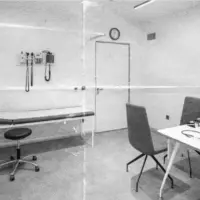
In Missouri, nearly 42% of counties are defined as maternity care deserts, higher than the nationwide average. Rural families face fewer options and greater distances to get OB-GYN care
For Dr. Kelsey Davis-Humes, practicing medicine in rural Missouri is a way of life. She’s on call almost constantly in northeast Missouri’s Scotland County, where she cares for patients from their birth until their death.
As an osteopath practicing in a rural community, part of her job includes caring for patients throughout their pregnancies.
“I do inpatient hospital coverage,” Davis-Humes said. “I deliver babies and do women’s health. I do pediatric care, newborn care. I am in the clinic. I go to the nursing home.”
While her area hasn’t lost an obstetrics unit in recent years, Davis-Humes has seen the impact on the state as a whole as pregnancy care becomes more difficult to access.
Missouri has lost 11 obstetric units since 2009, with seven of those in rural parts of the state, a report from the University of Minnesota Rural Health Research Center found. The closure of hospital obstetric units means women have to travel farther for their appointments and their deliveries.
As the units have closed, more parts of the state have fallen into maternity care deserts — areas without access to birth units or maternity care providers.
Based on 2023 data, Missouri is marked by more maternity care deserts than the nation as a whole. March of Dimes data shows that 41.7% of Missouri’s counties are classified as maternity care deserts, compared to 32.6% nationwide.
Part of the problem for rural providers? Medicaid payments. The government-sponsored health insurance plans do not reimburse obstetric care fully, meaning for every baby they deliver, the hospital takes a loss.
“Every hospital who does birth services loses money,” said Alison Williams, vice president of clinical quality improvement at the Missouri Hospital Association. Williams also leads Missouri’s Perinatal Quality Collaborative, a statewide task force dedicated to improving outcomes for moms and babies across the state.
In Missouri, about 40% of the state’s births were covered by Medicaid in 2023, KFF data shows.
As Medicaid cuts under President Donald Trump’s budget plan begin to materialize, anywhere from 130,000 to 170,000 Missourians are expected to lose their coverage over the next five years. The budget also changes how states can pay for Medicaid patients — and how much.
“We are going to be paid less,” said Craig Thompson, the CEO of Golden Valley Memorial Hospital in Clinton.
That could put rural hospitals with obstetric units at higher risk when it comes to continuing to offer their services, and will require more creative thinking from Missouri and its health care providers.
Rural Missouri’s maternity care shortage
Missouri’s health care challenges are compounded when it comes to maternity care. As health care services become more difficult to access, chronic conditions rise and lead to more complicated pregnancies.
Then, obstetric providers and care teams must be prepared to take on more high-risk pregnancies.
In Missouri, 68.7% of counties have a high burden of chronic health conditions and a high rate of preterm births, March of Dimes data shows, higher than the nationwide average. An estimated 45.5% of women living in Missouri had one or more chronic health conditions, compared to 37.8% nationwide.
“In general, you see more high-risk patients,” Davis-Humes said. “People are sicker, they’re more unhealthy, so we just see more patients that have more of these high risk conditions during their pregnancy.”
An added layer is the growing distance that rural women in Missouri must travel to get their care. Women living in maternity deserts — just over 40% of the counties in Missouri — have to travel 3.6 times farther than women living in areas with full access to maternity care.
That means things like prenatal care and regular checkups are even farther out of reach, and missing appointments raises the risk during pregnancy even more.
That’s showing up in Clinton and impacting how Thompson and his team think about maternity care. At their hospital, 63% of about 350 deliveries that happen every year are considered high-risk.
“Many Medicaid patients don’t have access to transportation, either they cannot afford transportation or there is no public transportation in rural Missouri,” Thompson said. “So without transportation access, people don’t have the ability to access that prenatal care, which then causes poor birth outcomes.”
And with high-risk pregnancies, soon-to-be moms in rural areas are drawn to more robust hospital systems with more speciality providers.
The downside to that, Williams said, is people who have the ability to travel to a larger hospital often take their commercial insurance with them, driving up the rate of deliveries that are covered by Medicaid for their nearby hospital and making it even harder to continue providing labor and delivery services.
“It creates an even larger, disproportionate share of Medicaid and vulnerable patients, or patients who don’t end up engaging in prenatal services,” Williams said.
As a hospital leader, Thompson and his team are committed to continuing to provide obstetric services in their hospital. But because so many of their births are covered by Medicaid and cost more than what they are paid, they rely on other services to cover that loss.
“If we were to look at those services on their own, they would be a significant financial drain to the system,” Thompson said. “We are kind of robbing Peter to pay Paul, to some extent.”
Plus, obstetricians and gynecologists, like most other medical providers, are looking for work-life balance, such as splitting their patient loads with multiple providers and other upsides that often come with working in a more populated area.
It can be difficult for rural providers to balance all of those needs, especially since monitoring labor and deliveries are so sporadic.
“If you have enough providers, you will likely have enough (patient) volume,” Williams said of rural providers looking to keep their birth units open. “The challenge is making sure you can maintain enough providers to where they have that work-life balance.”
What do health leaders want to see for OB-GYN providers moving forward?
As providers look to fill the gaps in maternal care, they’re leaning on innovative ways to ensure that every Missouri mother has access to adequate care.
For example, providers in Harrison County, which sits in northwest Missouri along the Iowa border, created a partnership with North Kansas City Hospital for labor and deliveries. Expecting mothers get prenatal care in the county, but travel to Kansas City for their deliveries. Afterward, patients are handed back to their providers in Harrison County.
Those types of partnerships are key to ensuring that mothers are followed every step of the way throughout their pregnancies, Williams said. Creating similar partnerships is one of the state’s goals moving forward.
“It’s important to have that good flow of prenatal records,” Williams said. “It’s important to have that connectivity, that handoff for the patient, so the patient feels like people know what’s going on with their care.”
The state is also focusing on recruitment and retention as part of the path to solving the problem. Davis-Humes mentors many aspiring doctors, who say that the workload of being on call constantly in rural communities is a deterrent for them.
“You’ve got to have people that are willing to come to an area and wear multiple hats, and also be willing to be called in in the middle of the night, too,” she said.
But she also wants to see more unique ways of encouraging rural providers to continue providing a service that makes them lose money.
“I think the state needs to put their money where their mouth is,” Davis-Humes said.
“We keep seeing all these birth centers close. We keep seeing that OB has a hard time making money … I think there should be some type of reward there,” she said. “You keep your OB center open, every year you get some sort of incentive from the state that says ‘Thank you … we’re going to help support you so you can continue to keep that OB unit open.’”
Although hospital executives are expecting to reassess their finances and the services they provide in the coming years as a result of Medicaid cuts, they are encouraged that they are seeing a new willingness to discuss the financial difficulties rural providers face.
“At some point, there has got to be real reform around reimbursement for rural health care services,” Thompson said. “We’re just not the same as our urban and suburban counterparts.”
This article first appeared on Beacon: Missouri and is republished here under a Creative Commons Attribution-NoDerivatives 4.0 International License.



